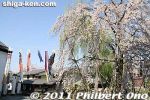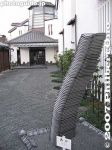|
|

Hachiman-bori is quite long and it even connects to Lake Biwa. The main part of moat is about 1 km long. I started walking here on the west end near the Omi-Hachiman Public Library. MAP
|
|

Hachiman-bori is also part of the National Important Traditional Townscape Preservation District (重要伝統的建造物群保存地区).
|
|

If the cherry blossoms are in bloom, I recommend walking along the canal from the west end since the sun will be on your back and on the flowers.
|
|

The cherry trees start from near the Omi-Hachiman Public Library. They continue all the way to the main torii of Himure Hachimangu Shrine.
|
|

Also during sakura season, the yakata-bune boats offer moat rides for 1,000 yen for adults. Boats leave from near The Kawara Roof Tile Museum on the east end of the moat.
|
|

I was in Omi-Hachiman to see the Hachiman Matsuri fire festival on April 14. I was lucky to find the cherries in full bloom at Hachiman-bori moat on a sunny day.
|
|

Perfect day to shoot cherry blossoms.
|
|
|
|
|
|
|
|
|
|
|
|
|
|
|
|

Mt. Hachiman-yama is in the background. An aerial tramway goes up the mountain which was the site of Hachiman Castle.
|
|

A few bridges also cross the moat. This is Meijibashi Bridge. 明治橋
|
|
|
|
|

Bridge in Osugi-cho. 大杉町
|
|
|
|
|
|
|
|
|
|

Yakata-bune tourist boat cruising through Hachiman-bori moat in Omi-Hachiman.
|
|
|
|
|
|
|
|
|
|
|
|

You can easily walk along the entire moat except for this section which is a little flooded. My waterproof shoes came in handy.
|
|
|

Hachiman-bori's highest concentration of cherry blossoms is near Hakuunbashi Bridge.
|
|
|
|
|

This bridge leads to Himure Hachimangu Shrine (to the left). This is the heart of Hachiman-bori moat.
|
|
|

Near Hakuunbashi Bridge, you can see two of the giant torches to be lit for the Hachiman Matsuri fire festval later in the evening.
|
|

Being the heart of Hachiman-bori, Hakuunbashi Bridge is where the sakura is concentrated the most. 白雲橋
|
|
|
|

Hakuunbashi Bridge and stone lantern. 白雲橋
|
|
|
|

View from Hakuunbashi Bridge. 白雲橋
|
|

View from Hakuunbashi Bridge. 白雲橋
|
|

Beyond Hakuunbashi Bridge, the moat goes to Kawara Roof Tile Museum and the moat boat dock. The cherry trees also stop, but there a few more on the far end of the most.
|
|
|
|
|

Unique, but controversial, bridge supported by two boats underneath.
|
|
|

Near the Kawara Roof Tile Museum is this dock where you board the moat boat. Fare is 1,000 yen for adults.
|
|

Kawara Roof Tile Museum
|
|

Kawara Roof Tile Museum in spring.
|
|

Kawara Roof Tile Museum's weeping cherry tree.
|
|

Kawara Roof Tile Museum's koinobori carp streamers and weeping cherry tree.
|
|

Kawara Roof Tile Museum
|
|

Kawara Roof Tile Museum's ground is covered with roof tiles, looking like cobblestones.
|
|

Outdoor sculpture at Kawara Roof Tile Museum, Omi-Hachiman, Shiga
|
|
|

Formerly a primary school built in 1877, Haku'unkan is now a tourist info office, souvenir shop, and exhibition space (2nd floor). 白雲館
|
|

Inside 1st floor of Haku'unkan. The building was beautifully restored in 1994.
|
|

2nd floor exhibition space of Haku'unkan.
|
|

Omi-Hachiman's manhole depicts Hachiman-bori moat adorned with cherry blossoms. Shiga Prefecture.
|
|

Another sakura spot is Hachiman Park next to Omi-Hachiman Pubic Library on the west end of the moat. 八幡公園
|
|
|
|
|
|
|
|
|
|
|
|

Hachiman Park cherry blossoms.
|
|
|

Hachiman Park is at the foot of Mt. Hachiman-yama.
|
|

Map of Hachiman Park.
|
|

Way to Toyotomi Hidetsugu statue.
|
|

Statue of Toyotomi Hidetsugu at Hachiman Park in Omi-Hachiman, Shiga.
|
|

Statue of Toyotomi Hidetsugu at Hachiman Park in Omi-Hachiman, Shiga.
|
|

Toyotomi Hidetsugu (豊臣 秀次 1568 – 1595) was a nephew and retainer of warlord Toyotomi Hideyoshi who lived during the Sengoku period of the 16th century.
|
|

Hachiman-bori goes all the way to Lake Biwa. This is toward the west end of the moat.
|
|
|
|
|
|